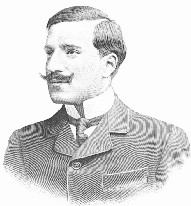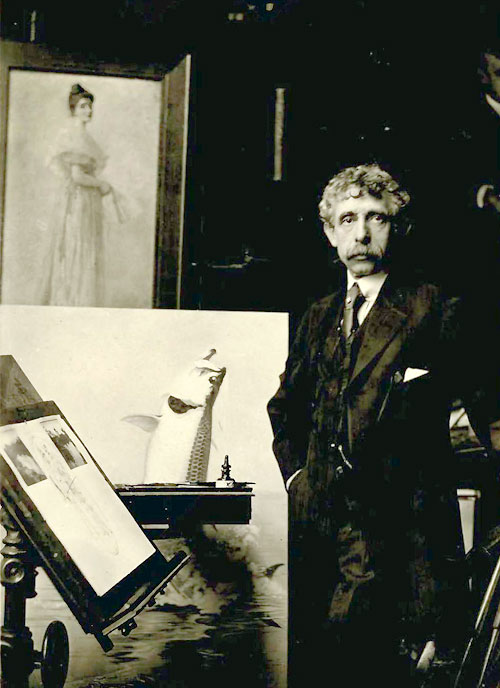The History of Poster Art over the last two Centuries. Part 4
Today we are continuing with our ongoing exploration on the History of Poster Art and the development of this art form over the last two centuries.
In Part 3 of this Blog I introduced Alphonse Mucha, Eugene Grasset and Théophile Steinlen who were featured in “Maitres de l’Affiche”- a publication that appeared from December 1895 to 1900 and was published by Jules Chéret- the “father of the modern poster” (see Blog #2 in this series for more info).
Next I want to focus on some of the other artists that were featured in “Maitres de l’Affiche” and in another publication called “L’Estampe Moderne”.
Leonetto Cappiello, Henri Meunier, and many others became important figures of their day, their art form transferred to magazines for advertising as well as for social and political commentary.
Leonetto Cappiello (1875–1942)
 Leonetto Cappiello (9. April 1875 in Livorno, Italy – 2. February 1942 in Cannes, France) was an Italian poster art designer who lived in Paris. He is now often called ‘the father of modern advertising’ because of his innovation in poster design. The early advertising poster was characterized by a painterly quality as evidenced by early poster artists Jules Chéret, Alfred Choubrac and Hugo D’Alesi. Cappiello, like other young artists, worked in way that was almost the opposite of his predecessors. He was the first poster artist to use bold figures popping out of black backgrounds, a startling contrast to the posters early norm.
Leonetto Cappiello (9. April 1875 in Livorno, Italy – 2. February 1942 in Cannes, France) was an Italian poster art designer who lived in Paris. He is now often called ‘the father of modern advertising’ because of his innovation in poster design. The early advertising poster was characterized by a painterly quality as evidenced by early poster artists Jules Chéret, Alfred Choubrac and Hugo D’Alesi. Cappiello, like other young artists, worked in way that was almost the opposite of his predecessors. He was the first poster artist to use bold figures popping out of black backgrounds, a startling contrast to the posters early norm.
Cappiello had no formal training in art. The first exhibition of his work was in 1892, when a painting was displayed at the municipal museum in Florence.
Cappiello moved to Paris in 1898 and started his career as a caricaturist illustrating in journals like Le Rire, Le Cri de Paris, Le Sourire, L’Assiette au Beurre, La Baionnette, Femina, and others. Later Cappiello began to move away from caricature work favoring posters. Cappiello made his name during the poster boom period in the early 20th century, with designs markedly different from premier poster artist Jules Chéret.
Cappiello’s career as a poster artist began in earnest in 1900 when he began a contract with the printer Pierre Vercasson. During this period, the printers would act as an agent for artists and commission work to them. Vercasson had a print house, and his goal was to bring color to the streets of Paris, he wanted the posters that he produced to stand out from the rest and attract lucrative new advertisers to his agency. Of course living in Paris, he was aware of the current art scene, and had seen many examples of Cappiello’s work, including a small number of posters already produced and in particular those for Le Frou-Frou.

Leonetto Cappiello; CARNAVAL, “Vinho do Porto”
He knew that Cappiello had the potential to be exactly what he was looking for. The relationship commenced with the arrangement that Vercasson would find the clients and brief Cappiello on the product. It was then up to Cappiello to produce a sketch for the client for which he would receive the fee of 500 francs, a good amount at the time. Once the design had been approved by the client a full size design would be produced for the poster at a size of 1×1.4m, an old French paper standard known as the Double Grand Aigle. Cappiello would also be responsible for ensuring the successful transfer of the design onto lithographic stone ready for printing.
In 1918 Capiello signed an exclusive contract with the Paris publisher Devambez for whom he designed now famous icons: such as Kub, Campari, Parapluie Revel, Pirelli, Chocolat Klaus and Poudre de Luzy, and the famous entertainer Mistinguette at the Casino de Paris.
Over the course of his career Cappiello produced more than 530 advertising posters.Today, his original posters are still sold at auction and sought after by dealers and collectors around the world.

Leonetto Cappiello; “Pates Baroni”
Henri Meunier (1873-1922)
He was a Belgian Art Nouveau lithographer, etcher, illustrator, bookbinder and poster designer of the Belle Époque.

Henri Meunier, “Rajah Coffee”
After studying at the academy in Ixelles, he diversified into printmaker, poster designer, graphic reporter and book binder. Meunier used flat colours and thick outlines, borrowed from Japanese prints, to achieve powerful images.

Henri Meunier, “Savon Starlight”
Many of his lithographs were published in L’Estampe Moderne, which appeared from 1897-98 as a series of 24 monthly portfolios, each of 4 original lithographs, priced at 3 francs 50 centimes and printed by F. Champenois of Paris.
Contributing artists included Louis John Rhead, Théophile Alexandre Steinlen, and Eugène Grasset.
We already introduced Steinlen and Grasset in previous blogs, here then some biographical notes and examples of Louis John Rhead’s work, an artist who brought the poster art of the “Belle Epoque” from Europe to the US.
Louis John Rhead (November 6, 1857 – July 29, 1926)
was an English-born American artist, illustrator, author and angler who was born in Etruria, Staffordshire, England. He emigrated to the United States at the age of twenty-four.
The Rhead family had operated and worked in the Staffordshire Potteries for at least three generations. Louis’s father George W. Rhead worked in the pottery industry and was highly respected gilder andceramic artist. In the 1870s, George Rhead taught art and design in Staffordshire schools. He founded Fenton School of Art.

Louis John Rhead in his studio circa 1920
Louis and all his siblings attended their father’s art classes and worked in the potteries as children. Because Louis demonstrated exceptional talent, when he was thirteen in 1872, his father sent him to study in Paris, France with artist Gustave Boulanger. After three years in Paris, Louis Rhead returned to work in the potteries as a ceramic artist at Minton and later at Wedgwood.
In 1883 at the age of twenty-four, Louis Rhead was offered a position as Art Director for the U.S. publishing firm of D. Appleton in New York City. He accepted and emigrated to the U.S. in the fall of 1883. In 1884 he married Catherine Bogart Yates, thus becoming an American citizen. Louis and Catherine lived in Flatbush overlooking Prospect Park for forty years.
In the early 1890s, Rhead became a prominent poster artist and was heavily influenced by the work of Swiss artist Eugène Grasset. During the poster craze of the early 1890s, Rhead’s poster art appeared regularly in Harper’s Bazaar, Harper’s Magazine, St. Nicolas, Century Magazine, Ladies Home Journal and Scribner’s Magazine. In 1895 he won a Gold Medal for Best American Poster Design at the first International Poster Show in Boston.

Louis John Rhead, Read the Sun, 1900
Between 1902 and his death in 1926, Rhead illustrated numerous children’s books published by Harpers and others. Most notable among these were editions of: Robin Hood, The Swiss Family Robinson, Robinson Crusoe, The Deerslayer, Treasure Island, Kidnapped and Heidi.
Rhead was an avid fly fisher and by his own account started fishing for trout in the U.S. sometime between 1888 and 1890.
Louis Rhead’s death was somewhat unusual. He died from a heart attack at his retirement home in Amityville, Long Island. A portion of his obituary in The New York Times, Friday July 30, 1926:
“LOUIS RHEAD, ARTIST AND ANGLER, DEAD. Exhausted Recently by Long Struggle In Capturing a 30-pound Turtle.
…About two weeks ago Mr. Rhead set out to catch a turtle weighing thirty pounds which had been devastating trout ponds on his place, Seven Oaks. After the turtle was hooked, it put up a fight for more than half an hour. Although Mr. Rhead was successful in the end, he became exhausted. A short time later he suffered from his first attack of heart disease. Yesterday’s was his second.”
To be continued… to view further works by these poster artists, please visit our web sites: classicvintageposters.com and islandartstore.com. Thank you for your interest in these blogs, your feedback is appreciated.
Bernard Lassalle
bernard@classicvintageposters.com